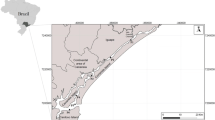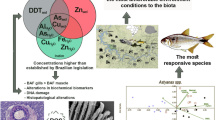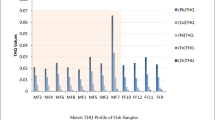Abstract
Biomarkers of fish health are recognised as valuable biomonitoring tools that inform on the impact of pollution on biota. The integration of a suite of biomarkers in a statistical analysis that better illustrates the effects of exposure to xenobiotics on living organisms is most informative; however, most published ecotoxicological studies base the interpretation of results on individual biomarkers rather than on the information they carry as a set. To compare the interpretation of results from individual biomarkers with an interpretation based on multivariate analysis, a case study was selected where fish health was examined in two species of fish captured in two ports located in Western Australia. The suite of variables selected included chemical analysis of white muscle, body condition index, liver somatic index (LSI), hepatic ethoxyresorufin-O-deethylase activity, serum sorbitol dehydrogenase activity, biliary polycyclic aromatic hydrocarbon metabolites, oxidative DNA damage as measured by serum 8-oxo-dG, and stress protein HSP70 measured on gill tissue. Statistical analysis of individual biomarkers suggested little consistent evidence of the effects of contaminants on fish health. However, when biomarkers were integrated as a set by principal component analysis, there was evidence that the health status of fish in Fremantle port was compromised mainly due to increased LSI and greater oxidative DNA damage in fish captured within the port area relative to fish captured at a remote site. The conclusions achieved using the integrated set of biomarkers show the importance of viewing biomarkers of fish health as a set of variables rather than as isolated biomarkers of fish health.





Similar content being viewed by others
References
Ariese F, Kok SJ, Verkaik MK, Gooijer C, Velthorst NH, Hofstraat DJW (1993) Synchronous fluorescence spectrometry of fish bile: a rapid screening method for the biomonitoring of PAH exposure. Aquat Toxicol 26:273–286
Australia New Zealand Food Standards (2015). http://www.foodstandards.gov.au/Pages/default.aspx. Accessed 15 May 2015
Bagherpour A, Soltanialvar M (2014) Measurement of heay metals (Hg, Pb) in the muscle of Black sole fish, Brachirus orientalis (Bloch & Schneider, 1801) in Adadan port. Adv Environ Biol 8:1228–1230
Bailey D, Soloman G (2004) Pollution prevention at ports: Clearing the air. Environ Impact Asses 24:749–774
Beck MW, Heck KL, Able KW, Childers DL, Eggleston DB, Gillanders BM et al (2001) The identification, conservation and management of estuarine and marine nurseries for fish and invertebrates. Bioscience 51:633–641
Cassi R, Tolosa I, de Mora S (2008) A survey of antifoulants in sediments from ports and marinas along the French mediterranean coast. Mar Pollut Bull 56:1943–1948
Corbett JJ, Winebrake JJ, Green EH, Kasibhatla P, Eyring V, Lauer A (2007) Mortality from ship emissions: a global assessment. Environ Sci Technol 41:8512–8518
Danion M, Le Floch S, Lamour F, Quentel C (2014) EROD activity and antioxidant defenses of sea bass (Dicentrarchus labrax) after an in vivo chronic hydrocarbon pollution followed by a post-exposure period. Environ Sci Pollut Res 21:13769–13778
da Silva DAM, Buzitis J, Krahn MM, Bicego MC, Pires-Vanin AMS (2006) Metabolites in bile of fish from Sao Sebastiao Channel, Sao Paulo, Brazil as biomarkers of exposure to petrogenic polycyclic aromatic compounds. Mar Pollut Bull 52:175–183
Dévier MH, Le Dû-Lacoste M, Akcha F, Morin B, Peluhet L, Le Mecach K et al (2013) Biliary PAH metabolites, EROD activity and DNA damage in dab (Limanda limanda) from Seine Estuary (France). Environ Sci Pollut Res 20:708–722
Dixon D, Hodson P, Kaiser K (1987) Serum sorbitol dehydrogenase as an indicator of chemically induced liver damage in rainbow trout. Environ Toxicol Chem 6:685–696
Eisler R (1987) Mercury hazards to fish, wildlife, and invertebrates: A synoptic review. Unites States Fish and Wildlife Service Biological Report 85
Francesconi KA, Lenanton RCJ (1992) Mercury contamination in a semi-enclosed marine embayment: organic and inorganic mercury content of biota, and factors influencing mercury levels in fish. Mar Environ Res 33:189–212
Fuentes-Rios D, Orrego R, Rudolph A, Mendoza G, Gavilan JF, Barra R (2005) EROD activity and biliary fluorescence in Schroederichthys chilensis (Guichenot 1848): biomarkers of PAH exposure in coastal environments of the South Pacific Ocean. Chemosphere 61:192–199
Gagnon MM, Hodson PV (2012) Field studies using fish biomarker–how many fish are enough? Mar Pollut Bull 64:2871–2876
Gobas FAPC (1990) Bioaccumulation of some polychlorinated dibenzo-p-dioxins and octachlorodibenzofuran in the guppy (Poecilia reticulata). Chemosphere 20:495–512
Goldstein RM, Brigham ME, Stauffer JC (1996) Comparison of mercury concentrations in liver, muscle, whole bodies, and composites of fish from the Red River of the North. Can J Fish Aquat Sci 53:244–252
Hallegraeff GM, Bloch C (1991) Transport of toxic dinoflagellate cysts via ships’ ballast water. Mar Pollut Bull 22:27–30
Hodson PV, Kloepper-Sams PJ, Munkittrick KR, Lockhart WL, Metner DA, Luxon PL, Smith IR, Gagnon MM, Servos M, Payne JF (1991) Protocols for measuring mixed function oxygenases of fish liver. Can Tech Rep Fish Aquat Sci 1829:51
Jones PD, Kannan K, Newsted JL, Tillitt DE, Williams LL, Giesy JP (2001) Accumulation of 2,3,7,8-tetrachlorodibenzo-p-dioxin by rainbow trout (Onchorhynchus mykiss) at environmentally relevant dietary concentrations. Environ Toxicol Chem 20:344–350
Kannan K, Smith JRG, Lee RF, Windom HL, Heitmuller PT, Macauley JM et al (1998) Distribution of total mercury and methyl mercury in water, sediment, and fish from south Florida estuaries. Arch Environ Contam Toxicol 34:109–118
Lowry OH, Rosenberg NJ, Farr AL, Randall RJ (1951) Protein measurement with Folin phenol reagent. J Biol Chem 193:265–275
Magnusson K, Ekelund R, Grabic R, Bergquist PA (2006) Bioaccumulation of PCB congeners in marine benthic infauna. Mar Environ Res 61:379–395
Martin LS, Nieto SR, Sanders BM (1996) Characterization of the cellular stress response in aquatic organisms. In: Ostander G (ed) Techniques in aquatic toxicology. CRC Press, Boca Raton, FL, pp 341–370
Otchere FA (2005) Organochlorines (PCBs and pesticides) in the bivalves Anadara (Senilis) senilis, Crassostrea tulipa and Perna perna from the lagoons of Ghana. Sci Total Environ 348:102–114
Papagiannis I, Kagalou I, Leonardos J, Petridia D, Kalfakakou V (2004) Copper and zinc in four freshwater fish species from Lake Pamvotis (Greece). Environ Int 30:357–362
Patiño R, VanLandeghem M, Goodbred SL, Orsak E, Jenkins JA, Echols K et al (2015) Novel associations between contaminant body burdens and biomarkers of reproductive condition in male Common Carp along multiple gradients of contaminant exposure in Lake Mead National Recreation Area, USA. Gen Comp Endocrinol 219:112–124
Richardson DM, Davies IM, Moffat CF, Pollard P, Stagg RM (2001) Biliary metabolites and EROD activity in flounder (Platychthys flesus) from a contaminated estuarine environment. J Environ Monit 3:610–615
Robb DHF, Wotton SB, McKinstry JL, Sorensen NK, Kestin SC (2000) Commercial slaughter methods used on Atlantic salmon: determination of the onset of brain failure by electroencephalography. Vet Rec 147:298–303
Scarcia P, Calamante G, de la Torre F (2014) Responses of biomarkers of a standardized (Cyprinus carpio) and a native (Pimelodella laticeps) fish species after in situ exposure in a periurban zone of Luján river (Argentina). Environ Toxicol 29:545–557
Stow CA, Carpenter SR (1994) PCB accumulation in Lake Michigan coho and chinook salmo: individual-based models using allometric relationships. Environ Sci Technol 28:1543–1549
Tomasello B, Copat C, Pulvirenti V, Ferrito V, Ferrante M, Renis M et al (2012) Biochemical and bioaccumulation approaches for investigating marine pollution using Mediterranean rainbow wrasse, Coris julis (Linneaus 1798). Ecotoxicol Environ Saf 86:168–175
Trevigen (2015) 8-oxo-dG ELISA kit & antibodies. http://www.trevigen.com/product/5/24/0/8oxodG_ELISA_Kit__Antibodies/. Accessed November 2015
Valavanidis A, Vlachoogianni T, Fiotakis C (2009) 8-Hydroxy-2′-deoxyguanosine (8-OHdG): a critical biomarker of oxidative stress and carcinogenesis. J Environ Sci Health C 27:120–139
Van der Oost R, Beyer J, Vermeulen NPE (2003) Fish bioaccumulation and biomarkers in environmental risk assessment: a review. Environ Toxicol Pharmacol 13:57–149
Water and Rivers Commission (1999) Albany waterways resource book. http://www.rivercare.southcoastwa.org.au/resources/awrb/info.html#ack. Accessed 15 May 2015
Webb D, Gagnon MM (2002) MFO induction potential of fish species native to the Swan-Canning River Estuary, Western Australia. Environ Toxicol 17:87–92
Webb D, Gagnon MM (2007) Serum sorbitol dehydrogenase activity as an indicator of chemically induced liver damage in black bream (Acanthopagrus butcheri). Environ Bioindic 2:172–182
Webb D, Gagnon MM (2009) The value of stress protein 70 as an environmental biomarker of fish health under field conditions. Environ Toxicol 24:287–295
Webb D, Gagnon MM, Rose TH (2005) Interannual variability in fish biomarkers in a contaminated temperate urban estuary. Ecotoxicol Environ Saf 62:53–65
Whyte JJ, Jung RE, Schmitt CJ, Tillitt DE (2000) Ethoxyresorufin-O-deethylase (EROD) activity in fish as a biomarker of chemical exposure. Crit Rev Toxicol 30:347–571
Author information
Authors and Affiliations
Corresponding author
Rights and permissions
About this article
Cite this article
Gagnon, M.M., Rawson, C.A. Integrating Multiple Biomarkers of Fish Health: A Case Study of Fish Health in Ports. Arch Environ Contam Toxicol 70, 192–203 (2016). https://doi.org/10.1007/s00244-015-0258-0
Received:
Accepted:
Published:
Issue Date:
DOI: https://doi.org/10.1007/s00244-015-0258-0




